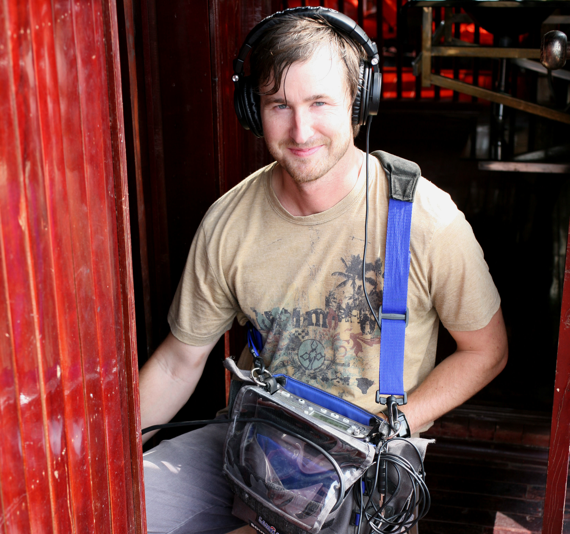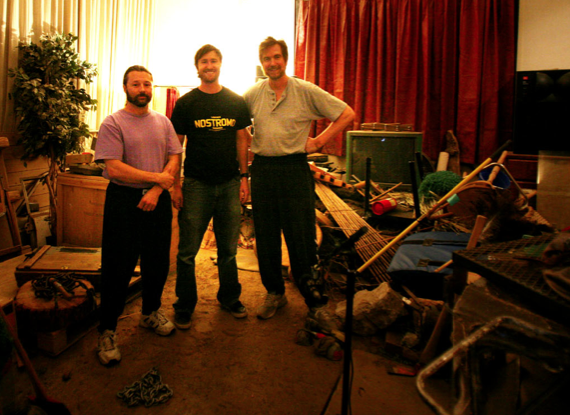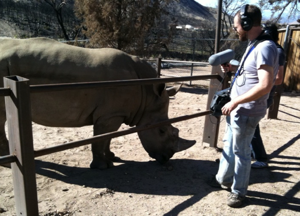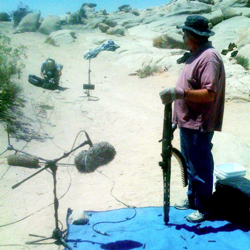
GETTING THE RECORDINGS
Recording is one of the most fun parts of the sound experience for me, yielding fresh material to work with and inevitably leading to unexpected ideas. I consider it central to the sound design process.
Part of the fun is the stories you’re left with. While recording, I’ve:
- Caught a microphone zeppelin on fire while doing stovetop ignition bursts (twice)
- Had a wolf jump up and attack my mic, hanging on a boom over a fence at a refuge in Arizona and pulling me off my feet
- Crushed a lavaliere mic inside a hydraulic press recording a coffee can crush
- Dropped a piano off a forklift, snapping the cable off a mic planted inside (sorry Kim)
- Watched as my friend Ethan nearly got torched recording the afterburners of a F22 Stealth Raptor fighter jet
- Hung out of the trunk of a Saleen sports car racing at 100 mph while recording the muffler
- Shattered my car windshield, with a mic in the driver seat, after dropping 50 gallons of water from a balcony
- Made a cow cry after separating him from his friends to get some moos. It was heart-breaking.
- Had my rig, with a home-made battery pack resembling a home-made bomb, confiscated by Shanghai airport police
- Been eaten by swarms of bugs recording jungle atmospheres in Cambodia
- Got elephant snot all over my Neumann microphone
I start recording sounds before starting a movie, building the library. Every new sound gets a specific three-letter code, followed by a three to four digit number that then gets catalogued with descriptive metadata in Soundminer for easy retrieval. For example, a big wooden door I recorded for Kung Fu Panda got the code and filename “KFP562 DOOR Big Wood Fox Bldg 29”. The door was at the main entrance to our mix building at Fox Studios, and while recording I could hear a subtle engine hum purring under everything. A little annoyed that someone would leave their car idling for so long and mess up my recording, I looked up from my recorder to ask whomever was parked in front of me to “PLEASE TURN OFF YOUR ENGINE!!!” Sitting in his Bentley was Steven Spielberg. I took a breath and decided to let him off the hook.
I do most recording in my design room, with small props or instruments or whatever I can record close up. Depending on the movie, and especially for action movies, I usually try to avoid getting any “room”, or reverb, in the recording. It’s easy to add later with Altiverb, but hard to remove if it’s tied to the recording. This means having an acoustically dead space.
I’ll also often spend several days on the foley stage recording wild sound effects, not to picture, collecting a palette to use for each movie.
The same way you’d record a musical instrument, you record a prop.
I treat everything I record like an instrument that needs a performance. Only I’m not limited to the instruments in an orchestra … the whole world is an instrument. I try to find the sweet spot of a given thing and not kill it. By not killing it, I mean don’t use tons of force to create a big sound. I find that some of the biggest sounds I’ve made are performed gently, so as to get a nice round richness out of the prop. Once you apply too much force, there’s all attack, all transience, and no round bottom. So for the big stuff, I’m often going gentler. Like in music, when you record a snare drum, if the drummer is slamming the drum with all his strength, all you get is a high end crack, which is fine if that’s what you’re going for. But if you want a rich, full, round snare, you lighten up and let the body ring out of the snare hit. So when I record a big metal hit for example, I try to get a smooth and elegant attack.
That said, some things I want to slam. Guns sound better to me when they saturate a mic or preamp. Vehicles can be the same way. As long as the sound doesn’t break up, I’ll push it into the red.
A lot of recording is done out in the field, like weapons and vehicles. For those kinds of shoots, we’ll run way more channels with a variety of microphones to get different angles and qualities in the sounds. John Fasal is the master of field recording, and I’m always learning tricks from him. On Transformers, we ran 14 channels for our weapons, recording on a Sound Devices 744, two 722s, an HHB 4 channel and a 1/4 inch analog Stereo Nagra for that fat tape saturation sound. We attached a DPA lavaliere mic to the barrel of each weapon, taking care not to get it too hot and melt. I ran my 191 close up, trying intentionally to fold the microphone element for a tasty “thump”. We ran a Pearl Sass stereo PZM about 10 feet back, getting a fuller richer perspective, plus some 4007s, Shoepps and a Sanken.
We were recording on a private range in Colorado, and unfortunately had to battle birds, wind noise, and air traffic. Sometimes you luck out with a location, sometimes you don’t.
We lucked out on the movie Valkyrie. We recorded a lot of the weapons for the North Africa sequence in a canyon, miles away from any road or bird. The natural acoustics of the canyon gave us a beautiful effect on the guns and the WW2 P-40 airplanes we were recording. We were recording during the actual production, and that’s always tricky. Sets are always chaotic, especially during action sequences which are complex and stressful to setup. We were fortunate to be given a production liaison with a gas-powered golf cart and walkie talkies to coordinate with the AD (assistant director), armorer and pilots.
The pyrotechnic crew did a number of explosion setups, which we had a lot of fun with. Ironically, the best explosion recording we got that week was from a cheap little 2-channel M-Audio Microtrack II recorder. I put it in a zip-lock bag and half buried it 5 feet away from a Nazi truck that exploded. The little mic overloaded and gave a perfect, huge, effect. Later in the day, I was caught downwind of a big explosion and spent that whole evening in the hotel room cleaning dirt and debris out of my gear with alcohol swabs and compressed air.
Vehicles often involve complex onboard mic hookups, with mics stationed along the course to get different angles on the rev aways, pass bys and in and stops. But I’ve found that the best racing sounds come from handheld angles, near the muffler, revving at 5000 RPM or more in first and second gears. Onboards frequently lack clarity and “beef”. Also, the skill of the driver is critical. On the first Transformers, we had a really gutsy stunt driver burning rubber for us. On the second Transformers, our driver was a bit timid and needed a lot of egging on. Our motorcycle driver, Tim, was incredible; seeing somebody pop a front-wheel-wheelie and keep it going for 1/4 mile is a sight to behold.
I record everything at 192 kHz, 24-bit, most of the time shooting M-S with my Neumann 191. M-S gives me the ability to dial in the stereo imaging later, getting a clean center or a nice wide image depending on the sound. I’m hoping Soundminer introduces a M-S decoder to their search engine, which would take a step out of the workflow when editing.
Sometimes I experiment with non-traditional microphones. I have several home-made hydrophones, which have come in handy for underwater recording like bubbles, swish bys and tones.
I have a few electromagnetic pickups for recording electrical fields. On I, Robot I used this kind of pickup extensively, collecting weird whines, hums and buzzes by moving the pickup around coffee grinders, copy machines, hard drives and anything electric. It was especially useful for sci-fi power-ups and power-downs, and gives a very nice and real organic feel to the synthetic nature of electromagnetism.
USING THE RECORDINGS
After each recording session, either an assistant will take the time to line up multi-channel angles and get them catalogued, or I’ll set up design sessions with the sounds. Typically I’ll load the raw recordings into ProTools, clean out the crap, and set up a chain of plugins on an insert. These may include an MS decoder, compressor/limiter, EQ, and whatever additional treatment might be appropriate depending on the sound. If I’m doing any extreme pitching or processing, I’ll work in a 192 kHz session to maximize fidelity and have all those extra samples to stretch, twist and manipulate.
I don’t wait to get the recordings mastered. I want to get them loaded quickly so they can be put to use right away. The longer you wait getting sounds loaded and mastered and given metadata, the less likely they’ll get used from the very beginning of the editorial process. I learned this the hard way the first few movies I worked on, where sounds recorded for one movie wouldn’t get used until the next.
One thing I try to keep in mind as I’m designing is how to make sounds that are different and unexpected. We’ve all the heard “clichés” of sound design: monsters made out of big animals, lasers made out of tension coil taps, spaceships made out of processed jets and the like. Clichés can be useful because they instantly reference a sub-conscious convention that is instantly recognizable by an audience. But it can also be fun to twist those conventions and surprise the ear with the unexpected. I’ve made a dragon out of a goose, a laser out of a cabinet creak and a spaceship out of my voice.
I’ll elaborate more on design in subsequent articles. But the ultimate goal is to make a sound that makes you go ” … WOW …”
Written by Erik Aadahl for Designing Sound




Interesting article. What I’d like to know though is people who are interested in this line of work, how can we ‘break in’ to the industry? What approaches or steps can be made to get into doing this work for a living. It’d certainly be a dream!
Hello Eric, thank you for the wonderful recording tips here. I had one question about the Neumannn RSM 191 stereo microphone and the MTX 191 A matrix amplifier. I assume you are using the MTX 191 A Matrix amplifier with your Sound Devices recorder? I am also using the RSM 191, MTX box, and SD-702 setup for most of my field recordings. I was curious if you had found a way to bypass using the MTX box? I know that the Sound Devices recorder is able to do MS-decoding and most of the functions of the MTX amplifier box. It would be nice to not lug that matrix amplifier around. Thanks Richard
Great article. Loved the on-site anecdotes. Funny and exciting. I’m curious though, what use were all the elephant recordings for?
Will, the elephant recordings are for “Shrek 4”.
Yea, what Richard asked…
Great stories!
Good stories Erik!
Do you have some videos using your Theremin ?
Thanks for share
Michel
Hi Eric
You don’t know me but I worked with your Dad at United. He has kept me up to date on your career for years.
So happy you are doing something you love. Take Care Dan
Dear Erik,
Great article. I’ve been following your work ever since Transformers. I’ve also been a huge fan of Ethan van der Ryn since Lord of the Rings.
I work as a resident recordist/mixer at a studio in L.A. and I do everything at 96K and I personally hate mixing at 48K. When I read that you record at 192 that blew me away.
Few questions if I may!:
How and when do you downsample to send it to the mixing stage?
Do you premix at 192, 96 or 48?
Do you ever record ambiences with the holophone or any other surround mic or do you always use your Neumann?
Really Interesting!! thanks a lot for tips!
Hey Richard, here’s for you:
http://www.sounddevices.com/notes/recorders/ms-stereo-monitoring/
Yeah, I’d like to know more about Erik’s Theremin setup too.
HI ERIK. GREAT VIDEOS, THIS ARTICLE WAS VERY HELPFUL , LOT’S OF INFORMATION ,THANK YOU